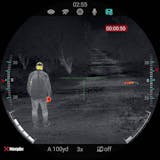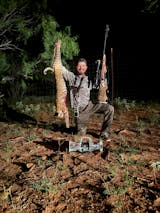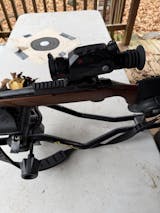
Mastering the Night: Coyote Hunting with Night Vision and Thermal Optics
Share
The Evolution of Coyote Hunting: Embracing the Darkness
Coyote hunting has long been a pursuit that tests a hunter's patience, skill, and understanding of animal behavior. Traditionally, this often meant dawn and dusk hunts, relying on natural light and keen senses. However, the advent and increasing accessibility of night vision and thermal optics have revolutionized the way we approach coyote hunting. These advanced technologies are not just luxuries but essential tools for serious predator hunters looking to extend their opportunities and increase their success rates. This article delves into the intricacies of coyote hunting with night vision and thermal optics, providing insights and guidance for both novice and experienced hunters.
Understanding the Technology: Night Vision vs. Thermal Optics
Before venturing into the field, it's crucial to understand the fundamental differences and applications of night vision and thermal optics in the context of coyote hunting.
Night Vision Optics
Night vision devices amplify existing ambient light (starlight, moonlight) to create a visible image. They typically operate by using image intensifier tubes or digital sensors.
- Image Intensifier (I2) Night Vision: This is the more traditional form, utilizing a vacuum tube to amplify light. Higher generation tubes offer better performance in low-light conditions but come with a higher price tag.
- Digital Night Vision: These devices use a digital sensor and a small screen to display the amplified image. They are often more affordable and can sometimes be used in complete darkness with the aid of an infrared (IR) illuminator.
Pros for Coyote Hunting:
- Can provide a clear, detailed image in moderately low light conditions.
- Generally less expensive than high-end thermal optics.
- Can identify specific features like fur color and eye shine.
Cons for Coyote Hunting:
- Performance degrades significantly in complete darkness or heavy fog/smoke.
- Requires an IR illuminator for absolute darkness, which can sometimes be detected by coyotes.
- Susceptible to 'whiteout' from direct light sources.
Thermal Optics
Thermal imaging devices, on the other hand, detect heat signatures (infrared radiation) emitted by objects. They create an image based on temperature differences, allowing you to see warm-bodied animals against cooler backgrounds, regardless of ambient light conditions.
- Monoculars and Binoculars: Handheld devices used for scanning terrain and identifying targets.
- Rifle Scopes: These are mounted on your firearm and provide a thermal view through the scope itself.
- Clip-on Devices: These attach to your existing daytime scope, converting it into a thermal optic without needing to re-zero.
Pros for Coyote Hunting:
- Excellent performance in complete darkness, fog, smoke, and even light rain.
- Can detect animals hidden by vegetation due to their heat signature.
- No need for external illuminators, making your presence less detectable.
- Can sometimes detect coyotes before they are visible to the naked eye or standard night vision.
Cons for Coyote Hunting:
- Significantly more expensive than most night vision options.
- Images can be less detailed than night vision, making positive identification of species at extreme distances sometimes challenging.
- Performance can be affected by extreme ambient temperatures or very hot ground.
Choosing the Right Gear for Coyote Hunting
The choice between night vision and thermal, or a combination of both, depends heavily on your budget, hunting environment, and personal preferences. For dedicated coyote hunting enthusiasts, investing in both can offer the ultimate advantage.
Night Vision for Spotting and Identification
A good quality night vision monocular or binocular is excellent for glassing fields and scanning treelines for coyotes. Their ability to show details can help confirm a target is indeed a coyote, especially at closer to medium ranges. For shooting, many hunters pair a traditional daytime scope with a night vision clip-on device or a dedicated night vision scope. However, be mindful of the IR illuminator's beam and its potential impact on coyotes.
Thermal Optics for Detection and Versatility
Thermal optics truly shine when it comes to detection. Their ability to cut through obscurants and reveal hidden heat signatures makes them invaluable for locating coyotes that would otherwise remain unseen. A thermal rifle scope is the most direct way to engage targets at night, offering a seamless transition from detection to shot. For those who prefer their existing scope, a thermal clip-on provides a robust alternative, allowing for quick target acquisition without the need for re-zeroing. Thermal monoculars are also superb for scanning and tracking coyotes that might be moving through dense cover.
Effective Tactics for Coyote Hunting at Night
Using advanced optics opens up new hunting strategies. Here are some effective tactics for coyote hunting after dark:
Pre-Hunt Scouting and Setup
Even with advanced optics, scouting remains critical. Identify known coyote travel routes, feeding areas, and bedding spots. When setting up your hunt, consider wind direction and potential approaches for coyotes. If using thermal, you can often detect coyotes moving in from a distance before they even reach your calling position. Position yourself with a clear field of view and a good backdrop for a safe shot.
Calling Techniques
Predator calls remain a cornerstone of coyote hunting. Electronic callers offer a wide range of sounds, from distressed prey to coyote vocalizations, which can be highly effective. Experiment with different calls and volumes. When a coyote responds, use your thermal or night vision to pinpoint its location and assess its approach. Patience is key; let the coyote work into the wind and into effective shooting range.
Utilizing Light Sources Wisely
If using night vision, an IR illuminator is often necessary. Choose one with adjustable intensity and beam focus. Start with a low setting and gradually increase it if needed, always being mindful of its potential to spook coyotes. Some hunters use a red or green light on a very low setting for brief moments to help with final target identification if their optics aren't providing enough detail, but this carries a higher risk of detection.
Shot Placement and Safety
With thermal and night vision, it's easier to identify a coyote in the dark, but making a positive identification is still paramount. Ensure you have a clear shot and a safe backstop. Understand the capabilities and limitations of your optics regarding range and target detail. Always prioritize safety for yourself and any hunting companions.
Legal Considerations for Night Hunting
It is absolutely essential to be aware of and adhere to all local, state, and federal regulations regarding coyote hunting, especially when hunting at night. Laws vary significantly by jurisdiction, and many have specific rules about:
- Seasons and bag limits for coyotes.
- The use of artificial lights.
- The use of electronic calls.
- Restrictions on hunting from vehicles or with the aid of specific types of optics.
Always consult your state's wildlife agency regulations before heading out. Ignorance of the law is not a defense, and violations can result in significant fines and penalties.
The Future of Coyote Hunting Technology
The technology behind night vision and thermal optics is constantly evolving. We can expect to see even more advanced, lighter, and more affordable options in the coming years. Features like integrated rangefinders, ballistic calculators, and even AI-powered target recognition are likely to become more common. As these technologies become more sophisticated, coyote hunting will continue to become more efficient and effective, offering hunters unparalleled opportunities to manage predator populations and enjoy the thrill of the hunt under the cloak of darkness.
Conclusion
Coyote hunting with night vision and thermal optics is no longer a niche activity but a mainstream practice embraced by hunters worldwide. By understanding the technology, choosing the right gear, employing effective tactics, and always prioritizing safety and legal compliance, you can significantly enhance your success and enjoyment of hunting coyotes after the sun sets. Embrace the darkness and unlock a new dimension of predator hunting.





